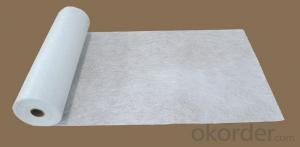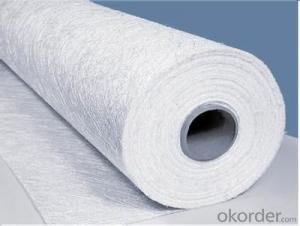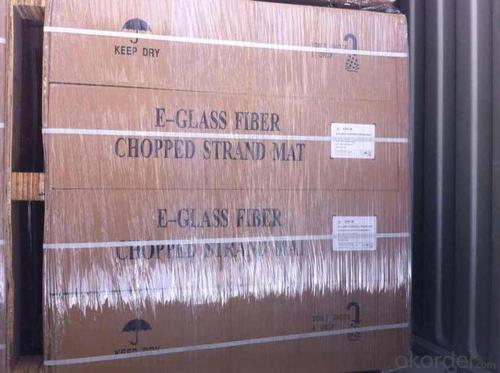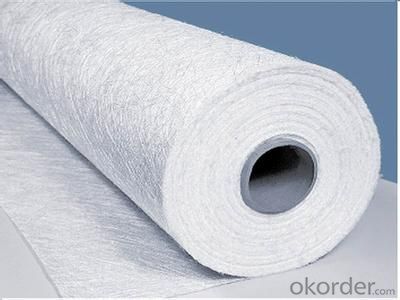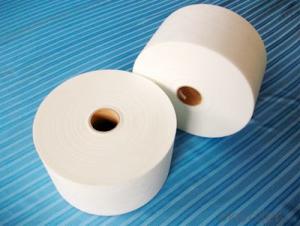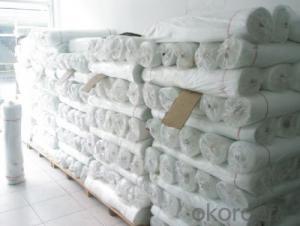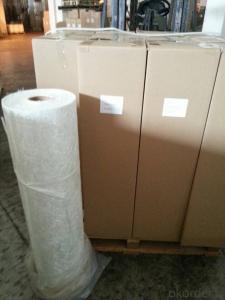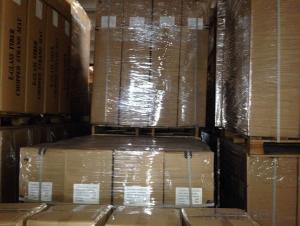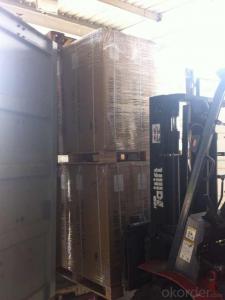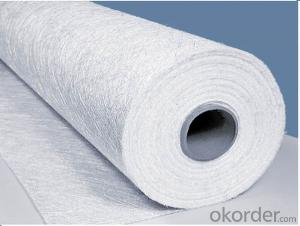Fiberglass Mat Tissue E Glass Fiber Chopped Strand Mat with Emulsion Binder Bonded
- Loading Port:
- Shanghai
- Payment Terms:
- TT OR LC
- Min Order Qty:
- 20000 kg
- Supply Capability:
- 200000 kg/month
OKorder Service Pledge
OKorder Financial Service
You Might Also Like
1.Brief Introduction
E-Glass Emulsion Chopped Strand Mat is made of randomly distributed chopped strands held tighter by a emulsion binder. It is compatible with UP, VE, EP resins.
It is compatible with UP, VE, EP, PF resins.
The roll width ranges from 50mm to 3300mm.
Additional demands on wet-out and decomposition time may be available upon request.
It is designed for use in hand lay-up, filament winding, compression molding and continuous laminating processes. Its end-use applications include boats, bath equipment, automotive parts, chemical corrosion resistant pipes, tanks, cooling towers and building components
2.Product Features
High tensile strength, allowing for use in hand lay-up process to produce large-area parts
Good wet-through and fast wet-out in resins, rapid air lease
Superior acid corrosion resistance
3.Product Specifications
Property | Area Weight | Moisture Content | Size Content | Breakage Strength | Width |
(%) | (%) | (%) | (N) | (mm) | |
Mathods | IS03374 | ISO3344 | ISO1887 | ISO3342 | |
EMC80E | ±7.5 | ≤0.20 | 8-12 | ≥40 | 50-3300 |
EMC100E | ≥40 | ||||
EMC120E | ≥50 | ||||
EMC150E | 4-8 | ≥50 | |||
EMC180E | ≥60 | ||||
EMC200E | ≥60 | ||||
EMC225E | ≥60 | ||||
EMC300E | 3-4 | ≥90 | |||
EMC450E | ≥120 | ||||
EMC600E | ≥150 | ||||
EMC900E | ≥200 |
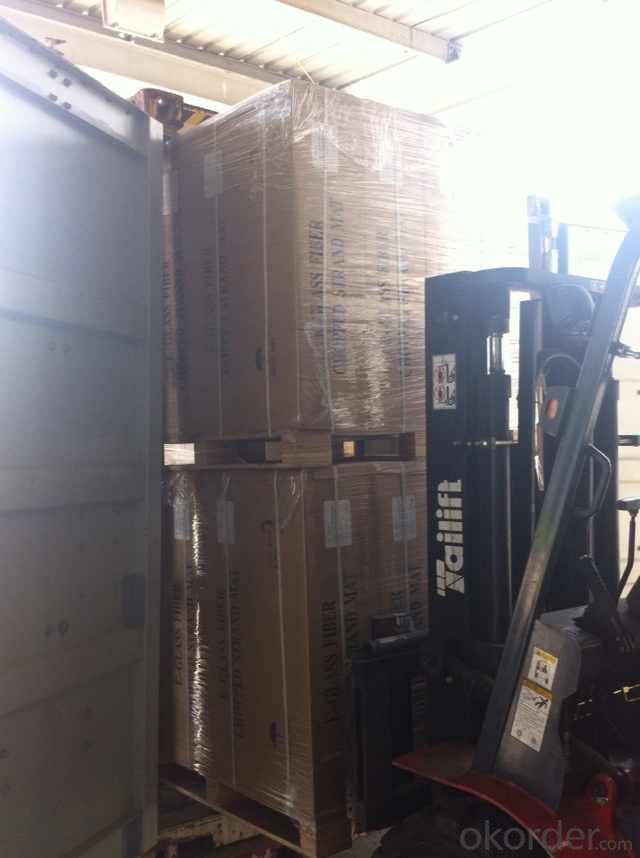 Packaging:
Packaging:
4.FAQ
Storage:
Unless otherwise specified, Chopped Strand Mat should be stored in a dry, cool and rain-proof area. It is recommended that the room temperature and humidity should be always maintained at 15℃~35℃ and 35%~65% respectively.
- Q: Can fiberglass mat tissue be used for creating molds?
- Using fiberglass mat tissue for creating molds is not possible. Fiberglass mat tissue is primarily utilized as a reinforcement layer in fiberglass composite applications due to its thin and lightweight nature. It is not intended to be used as a material for making molds. Instead, molds are commonly made using silicone, resin, or plaster, as these materials have the capacity to capture intricate details and offer a polished surface finish.
- Q: How does fiberglass mat tissue perform in high temperatures?
- Fiberglass mat tissue performs well in high temperatures as it has a high melting point and excellent heat resistance. It retains its strength and structural integrity even when exposed to elevated temperatures, making it suitable for various applications in high-temperature environments.
- Q: Can fiberglass mat tissue be used for making insulation blankets?
- Indeed, insulation blankets can be created by utilizing fiberglass mat tissue. This lightweight and flexible material is frequently employed in insulation scenarios. It possesses remarkable thermal insulation characteristics, as well as the ability to withstand fire, moisture, and chemicals. Moreover, fiberglass mat tissue is effortlessly manageable and installable, rendering it an optimal selection for fabricating insulation blankets applicable across diverse industries, including construction, automotive, and aerospace.
- Q: Can fiberglass mat tissue be used for composite pipe manufacturing?
- Fiberglass mat tissue is indeed applicable for the manufacturing of composite pipes. It is a reinforcement material commonly employed in the production of composite pipes. By providing strength and durability, it renders the pipes suitable for a wide range of applications. Typically, the fiberglass mat tissue is impregnated with a resin, such as polyester or epoxy, thereby facilitating the binding of the fibers to form a solid structure. This reinforcement material is renowned for its lightweight properties and exceptional resistance to corrosion, making it a highly desirable option for composite pipe manufacturing. Moreover, it can easily be molded into various shapes and sizes, allowing for the production of pipes with different diameters and lengths. As a whole, the utilization of fiberglass mat tissue in composite pipe manufacturing brings about numerous benefits, including increased strength, durability, and resistance to severe environmental conditions.
- Q: How is fiberglass mat tissue used in the production of composite panels?
- Fiberglass mat tissue is commonly used in the production of composite panels due to its unique properties and versatility. It serves as a reinforcement material that helps enhance the strength, durability, and overall performance of the composite panels. In the production process, fiberglass mat tissue is typically sandwiched between layers of resin to create a composite structure. The tissue acts as a reinforcing layer, providing additional strength and stability to the panels. It helps distribute the stress applied to the panel evenly, reducing the risk of cracks or fractures. One of the key advantages of using fiberglass mat tissue is its ability to improve the impact resistance of composite panels. The tissue absorbs and disperses energy when subjected to external forces, minimizing the risk of damage or breakage. This makes it an ideal choice for applications that require high impact resistance, such as automotive parts, boat hulls, or aircraft components. Fiberglass mat tissue also offers excellent corrosion resistance, making it suitable for use in environments with high humidity or exposure to chemicals. It acts as a barrier that protects the composite panels from moisture and corrosive substances, extending their lifespan and ensuring their long-term performance. Additionally, fiberglass mat tissue is highly moldable, allowing for the creation of complex shapes and designs. It can be easily molded into various forms, providing flexibility in the production process and enabling the creation of customized composite panels for specific applications. Overall, fiberglass mat tissue plays a crucial role in the production of composite panels by reinforcing the structure, enhancing impact resistance, improving corrosion resistance, and enabling flexibility in design. Its unique properties make it a popular choice in industries such as construction, transportation, aerospace, and marine, where high-performance and durable composite panels are required.
- Q: Can fiberglass mat tissue be used for insulation purposes?
- Yes, fiberglass mat tissue can be used for insulation purposes. It is commonly used as a layer in insulation systems to provide thermal resistance and enhance the overall insulation performance.
- Q: How is fiberglass mat tissue used in the production of shower enclosures?
- Fiberglass mat tissue is commonly used in the production of shower enclosures due to its excellent properties and benefits. It is a thin and flexible material made up of fine glass fibers that are randomly distributed and bonded together with a resin binder. In the production process of shower enclosures, fiberglass mat tissue is primarily utilized as a reinforcement material. It is often applied to the surface of the enclosure structure to enhance its strength, durability, and resistance to cracking or breaking. Firstly, the fiberglass mat tissue is cut and sized to fit the specific dimensions of the shower enclosure. It is then carefully laid or applied onto the surface of the enclosure, usually through a process called hand lay-up or spray-up. The mat tissue is positioned strategically to cover all the critical areas that require reinforcement, such as corners, edges, and joints. Once the mat tissue is in place, a resin, typically polyester or epoxy, is applied over it. The resin infiltrates the fiberglass mat tissue and bonds with the fibers, creating a solid and robust composite structure. This resin-fiberglass combination provides additional strength and stability to the shower enclosure, making it more resistant to impact, stress, and environmental factors like water and humidity. Moreover, fiberglass mat tissue also contributes to the overall aesthetics of the shower enclosure. It can help create a smooth and uniform surface finish, eliminating imperfections and creating a visually appealing appearance. The mat tissue can be easily molded or shaped to match different designs and styles, enabling manufacturers to produce shower enclosures with various shapes, sizes, and patterns. In summary, fiberglass mat tissue plays a crucial role in the production of shower enclosures by providing reinforcement, strength, durability, and aesthetic benefits. It is a versatile material that enhances the overall performance and visual appeal of the enclosures, ensuring they can withstand daily use and maintain their quality over time.
- Q: How does fiberglass mat tissue compare to fiberglass insulation batts?
- Fiberglass mat tissue and fiberglass insulation batts differ in composition, purpose, and usage. Fiberglass mat tissue, also known as fiberglass veil or fiberglass veil mat, consists of fine glass fibers woven into a thin fabric. It is primarily used to reinforce composites like roofing materials, laminates, and automotive parts, providing strength, durability, and resistance to cracking or tearing. This material is commonly employed in applications that require high tensile strength and dimensional stability. On the contrary, fiberglass insulation batts are thick, flexible panels made from compressed fiberglass fibers. These batts are specifically designed for thermal insulation and are commonly used in residential and commercial buildings. Their main function is to create a thermal barrier, improving energy efficiency by reducing heat transfer. Fiberglass insulation batts are typically installed in walls, attics, or crawl spaces to minimize heat loss or gain, resulting in better temperature control and reduced energy costs. It is essential to note the distinct purposes and applications of fiberglass mat tissue and fiberglass insulation batts when comparing them. Fiberglass mat tissue should not be used as a substitute for insulation batts, as it is not intended for thermal insulation. Conversely, fiberglass insulation batts are not suitable for use as a reinforcement material in composites. Regarding construction and installation, fiberglass mat tissue is commonly used in combination with other materials, such as resins or adhesives, to create a composite structure. It is easily cut, shaped, and molded to fit various shapes and sizes. On the other hand, fiberglass insulation batts are available in pre-cut sizes and can be easily installed by fitting them between framing studs or joists. Both fiberglass mat tissue and fiberglass insulation batts have their advantages and disadvantages, depending on the specific project requirements. While fiberglass mat tissue offers superior strength and dimensional stability for composites, fiberglass insulation batts excel in providing thermal insulation for buildings. Ultimately, the choice between the two will depend on the intended application and desired outcome.
- Q: Is fiberglass mat tissue suitable for sound absorption?
- Fiberglass mat tissue is indeed appropriate for sound absorption. Its exceptional acoustic properties make it a highly efficient material for decreasing noise levels and enhancing sound quality in different settings. The fibrous composition of the mat tissue offers a large surface area capable of absorbing sound waves and converting them into heat energy. This renders it an optimal choice for soundproofing walls, ceilings, and floors in buildings, as well as for automotive, industrial, and marine applications. Moreover, fiberglass mat tissue is lightweight, simple to install, and possesses excellent durability and fire resistance, further augmenting its aptness for sound absorption objectives.
- Q: What are the different grades of fiberglass mat tissue available?
- There are several grades of fiberglass mat tissue available, ranging from lightweight to heavyweight. These grades are typically classified based on their weight per unit area, with lighter grades being thinner and more flexible, while heavier grades are thicker and more rigid. The specific grades and their corresponding weights may vary depending on the manufacturer, but generally, they are categorized as light, medium, and heavy.
Send your message to us
Fiberglass Mat Tissue E Glass Fiber Chopped Strand Mat with Emulsion Binder Bonded
- Loading Port:
- Shanghai
- Payment Terms:
- TT OR LC
- Min Order Qty:
- 20000 kg
- Supply Capability:
- 200000 kg/month
OKorder Service Pledge
OKorder Financial Service
Similar products
Hot products
Hot Searches
Related keywords

